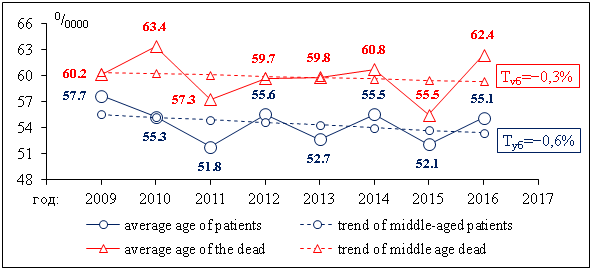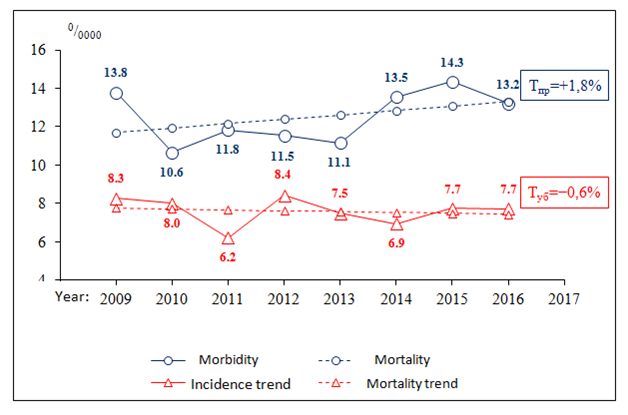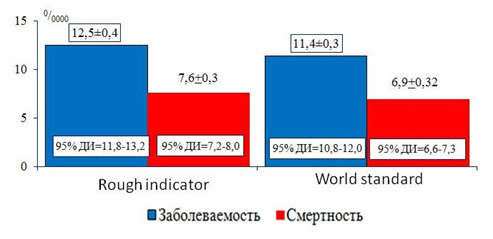eISSN: 2378-315X


Research Article Volume 8 Issue 2
1Tashkent City Branch of the Republican Specialized Scientific and Practical Medical Center of Oncology and Radiology, Kazakhstan
2Republican Specialized Scientific and Practical Medical Center of Oncology and Radiology, Kazakhstan
3Central Asian Cancer Institute, Kazakhstan
4Eurasian Institute for Cancer Research, Kazakhstan
Correspondence: Alieva Dilfuza, Republican Specialized Scientific and Practical Medical Center of Oncology and Radiology, Tashkent, Uzbekistan, Kazakhstan
Received: November 24, 2018 | Published: April 2, 2019
Citation: Almuhamedova BG, Alieva DA, Tillashaykhov MN, et al. Dynamic study of cervical cancer incidence and mortality in Tashkent city. Biom Biostat Int J. 2019;8(2):53-56. DOI: 10.15406/bbij.2019.08.00271
The purpose of this work is to assess the epidemiological features of incidence and mortality from cervical cancer (CC) in the city of Tashkent, based on a retrospective study from 2009 to 2016. In the period under study, 1,190 new cases and 722 deaths from cervical cancer were registered in Tashkent. The average age of the patients was 54.5 years, the deceased 59.9. It was found that the age-standardized rates of CC were 11.40/0000, mortality – 6.90/0000. The age peak of the incidence was observed in 45-64 years (30.70/0000), and the peak of mortality in 65 years and older is 28.40/0000. Trends in the age-specific morbidity and mortality rates in Tashkent had a different trend, which affected the increase in the incidence rate and the decrease in the death rate as a whole for the entire female population of the capital.
Keywords: cervical cancer, incidence, mortality, Uzbekistan, Tashkent city
Over 8 years (2009-2016) in Tashkent, 1,190 patients were registered with a first-time diagnosis of cervical cancer and 722 deaths from this pathology. The number of patients and deaths from cervical cancer in the age groups studied is presented in Table 1.
Age groups |
Sick |
dead |
||
Number |
% |
Number |
% |
|
18-44 |
288 |
24,2 |
113 |
15,7 |
45-64 |
661 |
55,5 |
374 |
51,8 |
65 and older |
241 |
20,3 |
235 |
32,5 |
Total |
1190 |
100,0 |
722 |
100,0 |
Average age |
M±m |
95% DI |
M±m |
95% DI |
54,5±0,5 |
53,4-55,5 |
59,9±0,7 |
58,6-61,2 |
|
Table 1 The number of patients and deaths from cervical cancer in the city of Tashkent for 2009-2016
Table 1 shows that the specific weight of patients with cervical cancer had unimodal growth with a peak in the group of 45-64 years - 55.5%, where the number of deaths was also numerous (51.8%) (Table 1). The average age of patients with cervical cancer in 2009-2016. was 54.5±0.5 years and, when aligned, had an undetectable tendency to decrease, and the average annual rate of decline was Tpr=+ 0.6%. The average age of the deceased was 59.9±0.7 years, the average annual rate of decline was Tub=-0.3% (Figure 1).

Figure 1 Dynamics of the average age of patients and deaths from cervical cancer Tashkent for 2009-2016.
The average annual rough incidence rate of cervical cancer in the capital's residents was 12.5±0.40/0000 (95% CI=11.8-13.20/0000), and in dynamics with this indicator leveling, there is a tendency to increase, the average annual growth rate was Tpr=+ 1.8% (Figure 2). An analysis of 95% confidence intervals of a rough incidence rate of cervical cancer for the years studied showed that they overlapped each other, and the differences were not statistically significant (p> 0.05), i.e. The formation of indicators was objectively influenced by the same causal factors. The average annual rough death rate from cervical cancer in the city was 7.6±0.20/0000 (95% CI=7.2-8.00/0000) and in the dynamics tended to decrease, and the average annual rate of decline during equalization was Tpr=−0.6% (Figure 2).

Figure 2 Dynamics of a rough indicator of morbidity and mortality from cervical cancer Tashkent for 2009-2016.

Figure 3 Average annual rates of morbidity and mortality from cervical cancer in the city of Tashkent for 2009-2016.
The incidence of cervical cancer in the entire female population of Tashkent for 18-44 years was 7.2±0.20/0000 (95% CI=6.8-7.60/0000). In 45-64 years, the incidence rate increased by 4.3 times compared with the previous group and amounted to 30.7±1.50/0000 (95% CI=27.8-33.70/0000). In the age group 65 years and older, the incidence rate was 29.1±2.60/0000 (95% CI=24.1-34.10/0000) (Table 2). Analysis of 95% CI age indices of cervical cancer in female residents of Tashkent showed that up to 45 years they did not overlap the indicators in older age groups. The reverse picture was in the age groups over 45, where 95% of the CIs were superimposed on each other, i.e. The differences were statistically insignificant. The average annual mortality rates from cervical cancer in Tashkent grow with age, and the peak of mortality falls on the oldest age group - 65 years and older - 28.4±2.20/0000 (Table 2). At the same time, analyzing the 95% CI of the age-specific mortality rates, it was established that they did not overlap each other, i.e. the difference was statistically significant (p <0.05), which indicated the influence of various factors affecting the formation of mortality rates from cervical cancer in different age periods. The trends in the age-specific incidence rates tended to increase in 18-44 years (Tpr=+ 2.6%) and at 45-64 years (Tpr=+ 2.8%), and the decline was observed in the older age group - 65 years and older (Tub=-5.7%) (Table 2). Trends in the age-specific mortality rates from cervical cancer in Tashkent have tended to decrease in 18-44 years (Tub=-2.6%), 65 years and older (Tub=-5.5%), and in 15-44 years, mortality had a tendency to increase (Tpr=+ 1.2%) (Table 2). Analysis of the ratio of mortality to morbidity showed that the highest values approaching unity were established in the age group 65 years and over - 0.98 (Figure 4), and in Tashkent as a whole, which is 0.61. It is established that the incidence and mortality from cervical cancer in Tashkent remain at a rather high level. Undoubtedly, the formation of these indicators in recent years has been influenced by the implementation of the reform processes in the country's healthcare system that have taken place in recent years, aimed at early diagnosis and prevention of oncology. There are also questions: "Why is the morbidity and mortality in the age group of 45-64?"; "What is the reason for the high rate of decrease in morbidity and mortality of cervical cancer in the age of 65 and older?"; "Why does the ratio of mortality to morbidity approach 1 in the same age group?". Undoubtedly, this is due to the problems of registration and registration of patients. We can not give single-valued and full answers within the framework of this article, since this requires further in-depth study and analysis.
Age groups |
Morbidity, 0/0000 |
Tpr / ub,% |
Mortality, 0/0000 |
Tpr / ub,% |
||
P±m |
95% DI |
P±m |
95% DI |
|||
18-44 |
7,2±0,2 |
6,8-7,6 |
+2,6 |
2,6±0,1 |
2,3-2,8 |
−2,6 |
45-64 |
30,7±1,5 |
27,8-33,7 |
+2,8 |
17,4±0,7 |
16,1-18,7 |
+1,2 |
65 and over |
29,1±2,6 |
24,1-34,1 |
−5,7 |
28,4±2,2 |
24,0-32,8 |
−5,5 |
Table 2 Age indicators of morbidity and mortality from cervical cancer in female residents of Tashkent for 2009-2016
a) In Tashkent, for the period under study, there were 1,191 new cases of cervical cancer and 722 deaths from this pathology. The average age of patients was 54.5 years, the deceased - 59.9 years, while in the dynamics there is an indistinct tendency to "rejuvenate";
b) The incidence of cervical cancer in Tashkent was estimated at a rough estimate of 12.50/0000 and the world standard of 11.40/0000;
c) Mortality from cervical cancer in Tashkent amounted to 7.60/0000 in the rough estimate and 6.90/0000 in the standardized indicator;
d) Age indices of cervical cancer showed unimodal growth with peak incidence in 45-64 years - 30.70/0000 and peak mortality - 65 years and older - 114.20/0000. In this case, the ratio of mortality to morbidity in this group had a maximum value of 0.98;
e) In the dynamics, the age-specific incidence rates had a different tendency and on the whole it affected the overall trend (Тpr=+ 1.8%); f) The trends of mortality rates as a whole declined (Tub=-0.6%), which was due to a decrease in the age groups 18-44 (Tpr=-2.6%), as well as 65 years and older (Tpr=-5.5%).
None.
Author declares that there is no conflict of interest.

©2019 Almuhamedova, et al. This is an open access article distributed under the terms of the, which permits unrestricted use, distribution, and build upon your work non-commercially.
2 7